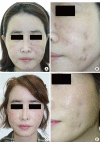Treatment of the Mycobacterium chelonae Infection after Fat Injection
- PMID: 25606492
- PMCID: PMC4297809
- DOI: 10.5999/aps.2015.42.1.68
Treatment of the Mycobacterium chelonae Infection after Fat Injection
Abstract
For recent years, use of autologous fat injection has increased significantly in facial contouring surgery. Along with such increase in use, complications like atypical mycoplasma infection have been also on the increasing trend. The authors report two cases of Mycobacterium chelonae infection that occurred after autologous fat injection. Patients were treated as infection that resistant to common antibiotics and results were negative to routine culture and Gram staining. Acid-fast bacillus stain, polymerase chain reaction (PCR) test and mycobacterial cultures were conducted for diagnosis under suspicion of atypical mycoplasma infection. Then, combination antibiotics therapy, surgical treatment, and steroid injection were performed for treatment. Both patients were diagnosed with Mycobacterium chelonae in PCR test. They were positive to mycobacterial cultures. Combination antibiotics therapy was repeated to improvement of symptom. However, they could not be free from side effects such as deformation in facial contour, scar and pigmentation even after full recovery. When chronic wound infections after autologous fat injection, we must suspect atypical or mycobacterial infection and conduct examinations for a early diagnosis and proper antibiotic therapy that is effective to the nontuberculous mycobacteria.
Keywords: Minimally invasive surgical procedures; Mycoplasma infections; Wound infection.
Conflict of interest statement
No potential conflict of interest relevant to this article was reported.
Figures



Similar articles
-
Cutaneous nontuberculous mycobacteria infections: A retrospective case series of 78 patients from the Texas Gulf Coast region.J Am Acad Dermatol. 2019 Sep;81(3):730-739. doi: 10.1016/j.jaad.2019.04.022. Epub 2019 Apr 16. J Am Acad Dermatol. 2019. PMID: 31002850
-
Mycobacterium Chelonae Infection of the Buttocks Secondary to Lipofilling: A Case Report and Review of the Literature.Aesthetic Plast Surg. 2017 Oct;41(5):1150-1154. doi: 10.1007/s00266-017-0890-3. Epub 2017 May 19. Aesthetic Plast Surg. 2017. PMID: 28526906 Review.
-
Severe Mycobacterium chelonae Infection Following Dermal Filler Injection: A Diagnostic and Therapeutic Challenge.Cureus. 2025 Feb 27;17(2):e79784. doi: 10.7759/cureus.79784. eCollection 2025 Feb. Cureus. 2025. PMID: 40161194 Free PMC article.
-
[Postoperative infection with Mycobacterium chelonae].Hautarzt. 1996 Nov;47(11):863-6. doi: 10.1007/s001050050523. Hautarzt. 1996. PMID: 9036143 German.
-
Nontuberculous Mycobacteria: Skin and Soft Tissue Infections.Dermatol Clin. 2015 Jul;33(3):563-77. doi: 10.1016/j.det.2015.03.017. Epub 2015 May 8. Dermatol Clin. 2015. PMID: 26143432 Review.
Cited by
-
Comparisons between fresh and cryopreserved fat injections in facial lipofilling.Arch Craniofac Surg. 2020 Feb;21(1):15-21. doi: 10.7181/acfs.2019.00612. Epub 2020 Feb 20. Arch Craniofac Surg. 2020. PMID: 32126615 Free PMC article.
-
Mycobacterium avium Infection after Acupoint Embedding Therapy.Plast Reconstr Surg Glob Open. 2017 Sep 26;5(9):e1471. doi: 10.1097/GOX.0000000000001471. eCollection 2017 Sep. Plast Reconstr Surg Glob Open. 2017. PMID: 29062643 Free PMC article.
-
Cause Analysis of an Infection in Facelift Surgery Due to Mycobacterium chelonae.Front Med (Lausanne). 2019 Nov 7;6:243. doi: 10.3389/fmed.2019.00243. eCollection 2019. Front Med (Lausanne). 2019. PMID: 31788475 Free PMC article.
References
-
- Dessy LA, Mazzocchi M, Fioramonti P, et al. Conservative management of local Mycobacterium chelonae infection after combined liposuction and lipofilling. Aesthetic Plast Surg. 2006;30:717–722. - PubMed
-
- Kim JT, Seo WJ, Kim YH. Clinical considerations on contamination rates of cryopreserved autologous fat. J Korean Soc Plast Reconstr Surg. 2009;36:685–690.
-
- Kim HI, Hwang SM, Song JK, et al. Epidermal inclusion cyst after fat injection: a case report. Arch Aesthetic Plast Surg. 2011;17:181–183.
-
- Lee BS, Kim TR, Yoo SW, et al. A clinical analysis of nosocomial coagulase negative staphylococcal bacteremia. Korean J Intern Med. 1991;40:240–249.
-
- Kaufman MR, Miller TA, Huang C, et al. Autologous fat transfer for facial recontouring: is there science behind the art? Plast Reconstr Surg. 2007;119:2287–2296. - PubMed
LinkOut - more resources
Full Text Sources
Other Literature Sources

